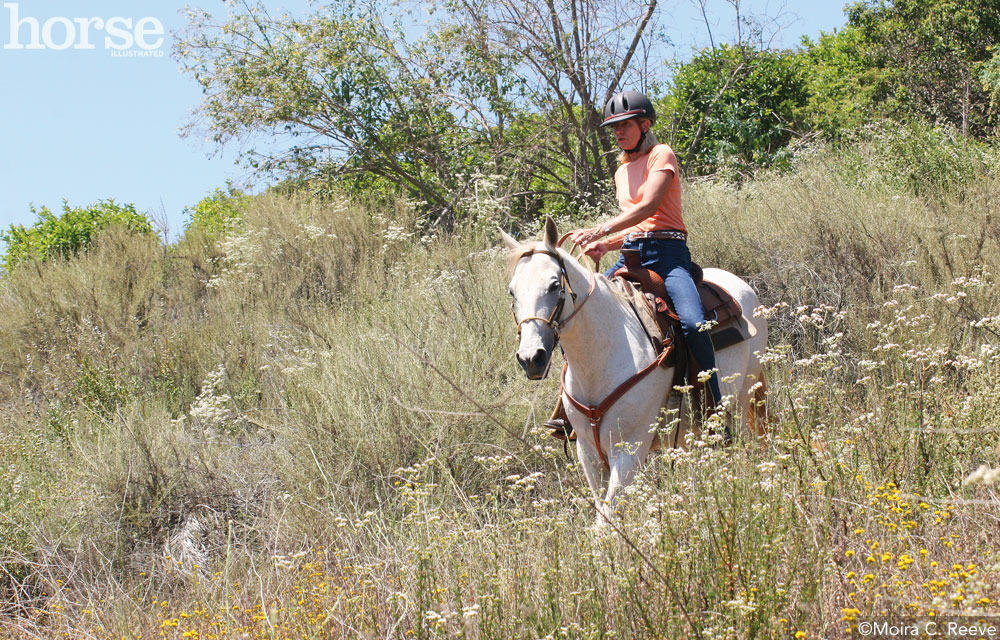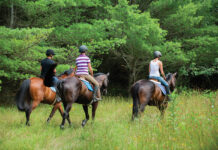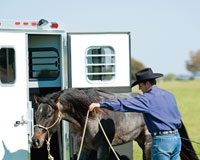Q. My 4-year-old mare kicks out and bucks while going downhill on trail rides. My veterinarian has ruled out health problems. How can I correct this dangerous behavior?

If going downhill is the only time she exhibits this behavior, consider these possible factors:
- She may get out of balance when carrying you downhill; and/or
- your saddle could be slipping forward, causing pain in her shoulders.
Try to pinpoint the reason for this behavior as soon as possible. Until you can find the reason for the kicking out and bucking, just get off and walk down hills with your horse. Here are some solutions to try.
Balance Issue:
Lead (or pony) your horse downhill, observing her movement and attitude. Does she walk downhill comfortably, or is she agitated or worried? If she is having trouble balancing herself downhill, experiment on a hill that is not as steep to help her become comfortable and confident on a decline.
Many horses do not use their hindquarters to their advantage when traveling downhill, which puts too much weight on their forehand. A simple exercise to help your horse use her hindquarters more efficiently is practicing backing up.
Try this on line at first (i.e., not mounted) and on level ground. Ask for a few slow steps until she can back straight, soft and calm. Slowly work up to more distance and speed while backing. You can also try backing up a slight incline. Every time you ride, practice backing up.
Saddle Issue:
If your saddle is causing your horse pain, you can certainly understand why she would be upset. The kicking out and bucking is her way of saying: “GET OFF!” A simple tack adjustment, such as using a crupper, could help to keep the saddle from sliding forward. You may also want to investigate other saddle options to find one that will keep your horse comfortable and happy.
Before you ask your horse to wear a crupper, you must prepare her for it. Most horses do not like having something under their tail—it is a very sensitive and vulnerable area. Start off by gently petting and scratching around the top and sides of the tail until your horse lifts her tail. Then use a soft rope, until you can put it up under her tail without worrying her.
The first time you ask her to wear the crupper, she should be in an enclosed area. Adjust the crupper so that it has some slack to allow for the horse’s normal movement. Let her eat off the ground so she can feel the crupper under her tail. Don’t get on until she has walked, trotted and cantered with the crupper on and she is comfortable wearing it.
An avid Parelli Natural Horse-man-ship student, Traci Falcone has completed more than 4,000 miles on endurance rides, including four Tevis Cup “100 Miles in One Day” rides. In 2004, she rode Tevis bridleless.






something may be pinching her or something u can call ur vet and make an apt. w/ them w/ ur saddle on
This does sound like a saddle fit problem but might also be an alignment issue. I’d have the horse seen by an equine chiropractor.
Can someone tell me how to stop a 6 year old horse from bucking. I’ll ride her she’s fine I get back on after a break and she bucks till I fall off then stops. I’ve had her vet checked and saddle fits? Help
I never knew horses could buck while going down a hill.
I used to ride a horse who would buck downhill. She did it because the saddle was hurting her shoulders. You should definitely check the fit.